BY ROB FELD
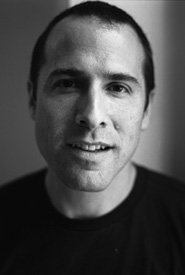 MUSIC TO HIS EARS: David O. Russell
MUSIC TO HIS EARS: David O. Russell
says Mel Brooks' Young Frankenstein
is like a demented operatic comedy.
"This movie is like a duet sung by Mel Brooks and Gene Wilder," declares David O. Russell, as we sit in his den to watch Brooks' 1974 classic comedy, Young Frankenstein. "The film comes together perfectly and symmetrically because they are naturally following their true voices. As ingenious as all Brooks' films are, this is my favorite."
Russell, director of the un-Brooksian Three Kings and the more manic Flirting with Disaster, says he first encountered the film in high school in 1974. "I remember it vividly. 1974-1976 were extraordinary years for movies: Chinatown, The Conversation, Dog Day Afternoon, Shampoo. When one came out that we were really excited about, a whole bunch of us would drive into New York. We probably saw Young Frankenstein three or four times, then again when it came to New Rochelle. We quoted it and used those voices our whole junior and senior years."
And he still does, taking obvious pleasure in reciting the lines that have stuck with him for years. "What's funny in Brooks' universe is people with high levels of conflict and desire and wearing it on their sleeves," Russell continues. "I always say that comedy just takes what people are feeling all the time and puts it on their sleeves so we can laugh, because we all feel that stuff inside ourselves. A 6 year old can express it whenever he wants, but we can't. So it's funny to see somebody struggling with all that shit, and that's what Brooks shows us."
In form and content, Brooks' film parodies James Whale's 1931 Frankenstein, even down to using some of its original laboratory equipment. In Young Frankenstein, Brooks' co-writer and star Gene Wilder plays the haunted grandson of Dr. Frankenstein who is ashamed of his family past. He maniacally corrects others in the pronunciation of his name, which he has restyled as Fronkensteen. Brooks shot the film in black and white, imitating the style and conventions of the original film.
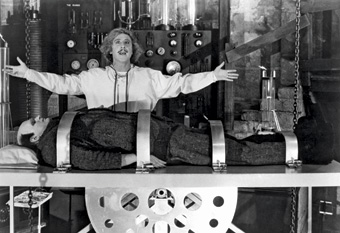 MAD SCIENTIST: Dr. Frankenstein (Gene Wilder) celebrates bringing
MAD SCIENTIST: Dr. Frankenstein (Gene Wilder) celebrates bringing
his creation to life. Peter Boyle as the monster looks sweet and scared
and "the fact that he's got male pattern baldness is inspired." "It's a complete homage to Whale's film and his love for its tone," says Russell, "but he orchestrates a level of broadness that is operatic. Brooks is the opera maestro of comedy, with a big, expansive personality that I relate to. It's emotional and expressive, big appetite, kind of crazy. And that's how his movies are; they're not understated and not like anything else. But Young Frankenstein is probably his most disciplined picture because he's staying so true to the original. He has his actors play it straight; they keep the winking to the camera to a minimum, so it has more depth and grounding than a free-for-all like Blazing Saddles. The drier Brooks plays things the funnier they are, so here he avoids contemporary references and stays rooted in the genre of the classic."
The credits roll over a slow pull-in on an iconically spooky hilltop castle on a rainy night, then a dissolve and we move through a window to see the hands of a grandfather clock at midnight. "Keeping us in the original, he does all the credits upfront in an old-fashioned style, but the genius of this opening is the anticipation," notes Russell, as the camera slowly pans the room and finds a sarcophagus marked "Baron von Frankenstein." "You know it's a Mel Brooks film so the expectation is huge for when it's going to get insane and funny. The buildup is a great pleasure, like foreplay. I don't think Brooks could get away with it if his audience wasn't prepared for what lay ahead," Russell says.
As the action starts with 'Dr. Fronkensteen' soberly lecturing his class of med students, Russell comments on the method behind the director's madness. "I think he was aware he had that dramatic tension and that you knew a crazy comedy was coming. But I don't think it's like Brooks sits back and makes up a rhythm for when to let the hysteria out. His characters are intense, even when they're being quiet, so I think a very natural rhythm develops which is grounded in the character."
Brooks slowly unravels Wilder's character, a doctor who carries himself with a certain decorum. "That's what half the comedy is about," says Russell, "he is this dignified, professional scientist with all the messy humanity bubbling underneath."
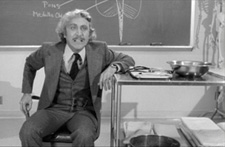
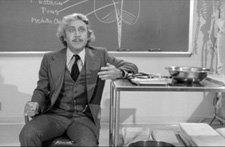
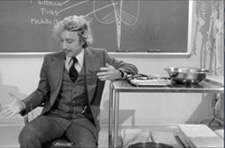
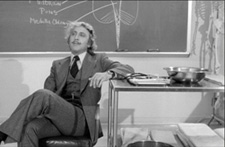 Dr. Frankenstein does a slow burn
Dr. Frankenstein does a slow burn
as he unravels in his classroom. Russell cracks up as he watches Wilder, who is calm until a wormy little student pronounces his name 'Frankenstein.' Brooks milks comedy from Wilder's ability to depict a frenzied restraint, as the student continues to goad him about his grandfather and heritage.
"It's this tension in the voice of this man of science that verges on hysteria," Russell marvels. "He's struggling to contain it, which I think is an emotion a lot of us feel." In his tantrum, Wilder accidentally stabs himself in the leg with a scalpel and tries to hide it from his class. "He brings it down, like he's controlling it but could almost start crying or screaming again. We can feel that cracking in his voice. It's a performance, but the director's hand is in all of it. I imagine the first thing Brooks did was cast five ingenious comedians, people who know how to just sit there and pick up a napkin in a way that's going to be funny."
In a sendup of a classic shot, Brooks' camera tracks along a train platform until it comes upon Wilder, face to face with Madeline Kahn, his frigid and princessy fiancée. She is bidding him farewell as he follows his destiny to Transylvania. The director plays the scene as almost-straight melodrama. Engine steam surrounds them but she is more Jewish mother than betrothed lover, repeatedly dousing Wilder's seething lust. When Kahn protects her lipstick, hair or taffeta dress from being mussed, Russell interprets the scene: "I'm yours but you can't touch me."
"They took themselves very seriously making the original Frankenstein," he says, "treating it almost like Brecht or Carl Dreyer. But I think Brooks knows that when you serve up the quiet, serious attitude of the cinematic language from the '30s, with everybody being super sincere and intense, it's going to be funny. The original Frankenstein is funny if you watch it now. So Brooks makes every single thing so serious and ominous, laden with some unspoken meaning.
"I would say that's a big part of the comedic rhythm here," Russell continues, "that human thing of what I'm not going to say. When there's this big, horrible, unspoken thing that people don't acknowledge but try to work their way around, it's weird and funny, like Wilder's lust for Kahn."
Once ensconced in his grandfather's castle, Wilder wakes from a nightmare to find by his bedside the sexiest thing in Transylvania, his new lab assistant Teri Garr. And he hears strange violin music coming from behind the bookcase. "So many of these scenes are like master class comedic set pieces," Russell says in anticipation of the slapstick of a spinning bookcase, "and they all play with something so simple."
Wilder and Garr soon find themselves struggling to figure out how the bookcase opens and closes by removing and replacing a candle from its triggering wall mount. Each time Wilder gets caught behind the bookcase he calls to Garr through the wall, in that metered, condescending, authoritative doctor's voice, "Put-the-candle-back!" which by itself is hysterically funny. After a couple of failed maneuvers to escape, Wilder gets stuck between the case and the wall. He instructs Garr not to put the candle back but to throw her body against the other end of the case, and she gets trapped.
"Brooks takes the gag to the first level with 'Put-the-candle-back!' Russell explains. "Then Wilder gets slammed and 'Don't-put-the-candle-back.' Then part three and she gets stuck behind and shouts 'Put-the-candle-back!' It becomes symmetrical, poetry that finds its own math."
As Russell points out, Brooks edits sparingly but effectively in the scene. He cuts away to Garr just before Wilder gets slammed by the bookcase. "Ha! You don't see him get squashed. Brooks takes it off screen, leaving you with the sound and her facial expression, and it's funnier. I wonder how that developed? It could be an example where necessity breeds brilliance; maybe the way they tried the stunt in reality wasn't as good because you couldn't hit Wilder that hard with a bookcase and have him trapped there and make it look funny. But I think when off-screen things are set up brilliantly like that, you can't beat them. This is like a Picasso of an off-screen crash.
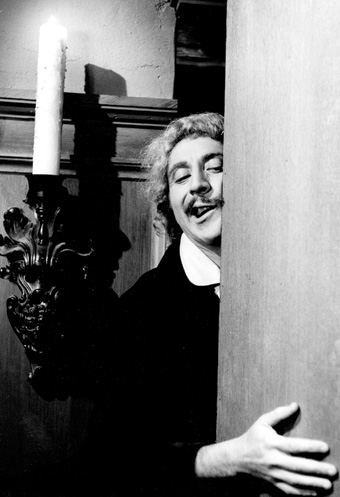 TOUGH SPOT: In a classic gag, Wilder discovers a secret
TOUGH SPOT: In a classic gag, Wilder discovers a secret
passageway triggered by the candle on the wall.
"And 'Put-the-candle-back!" Russell almost sings. "Brooks just loves the music of the way people talk and how odd it can sound. The timbre of their voices, the rhythm of the way they talk, the musicality of it—Brooks has totally dialed in to it. He's tickled and fascinated by the way people sound when they're serious, when they're upset, when they get upset, when they try not to get upset. Brooks plays with all that, having endless fun with that turn of phrase while in the context of this brooding, serious 1930s genre."
Finally conquering the bookcase, Wilder and Garr proceed down the creepy stairs. In a moment of high tension, Wilder reaches for a doorknob, which disintegrates ridiculously in his hand. "Those buildups and anticlimaxes are so great," Russell enthuses. "I love using cinematic cliché to turn a moment and the gag on its head. The violin strings build and the thing crumbles in his hand. Brooks takes a convention, uses the buildup, keeps teasing us with it and then turns the expected payoff on its head."
Wilder and Garr meet up with a hunchbacked Marty Feldman (Igor, which he pronounces I-Gore) in the hidden laboratory and, to cap a gag, Feldman nuzzles Wilder's shoulder with his hump. It's a subtle Marx Brothers throwaway—one could even imagine improvised on the spot. "My guess is that Brooks knew when to seize on those small things and encourage them, and when he wanted to contain them," Russell says about Brooks' perfect pitch. "The Key of Mel. You can do operatic comedy with only the simplest of characterizations and give it depth, like styling Madeline Kahn as the spoiled, rich daddy's girl. Is she going to let him touch her? It's extremely specific and we understand who that girl is, but the simplicity creates amazing tension that gives great scope."
When it's time to steal the body that will become the monster, Brooks takes us briefly out of the castle and into town. "The shots are classically and beautifully composed," Russell says. "He's following the language of the original film, the lighting and framing, a lot of singles."
Back in the laboratory, Peter Boyle, as the monster, has been brought to life and lies strapped onto the table. "Look at Boyle's face in that huge overly pronounced brow," says Russell. "He looks sort of sweet and scared inside there, and the fact that he's got male pattern baldness as a monster is inspired."
But success is fleeting when Wilder realizes that Feldman stole the wrong brain. As Wilder attempts to control his rising fury at Igor, Russell points out how Brooks is rarely making his jokes with cuts, but rather with the performances of his ensemble. "Almost always when you have things play in one take they have a life to them, which they can't have in cuts."
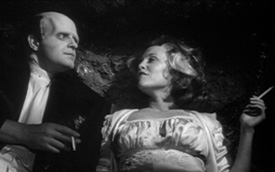 CRAZY LOVE: Madeline Kahn and the monster share a
CRAZY LOVE: Madeline Kahn and the monster share a
post-coital cigarette and the film ends on an operatic note.
In a close two-shot, Brooks lets the interaction play out as Wilder calmly questions Igor about the brain, promising he will not be angry. "Having Wilder underplay his fury here is genius," says Russell. "Watch him, watch him. We're just waiting for Wilder to explode," marvels Russell. "He's such an inspiration to me. While making [my latest film] Nailed I would refer to Wilder as the method actor of comedy because he's got that crazy intensity, like my Italian and Jewish relatives. He's never winking or doing a bit. He's always invested. And, with his Frankenstein monster, he's like a filmmaker with a movie: 'All I need is to complete this picture in the editing room, then I'll show everyone it lives!'
Like all of Brooks' films, sex isn't far off, and Russell notes how Wilder's scientific trajectory runs parallel to his sexual investigations with Garr. "Brooks' energy is very sexual, but sexual like 'I'm going to bite your leg' sexual," explains Russell. "So in the second act when Wilder finally screams and embraces his own name—Frankenstein—it's like a big orgasm. The movie is, on some level, all about sex, love, and losing control."
Even the monster comes of age and has his sexual awakening when he kidnaps Kahn, who has come to Transylvania after her man, but not realizing it's this one. She puts up a fight but quickly acquiesces when she sees how well endowed he is, bursting into operatic song upon entry. "It's so perfect that the film culminates in the sound of opera," Russell says.
"I love this next speech Kahn gives as the monster is entranced by the violin music Wilder is playing for him and starts to leave. She gets all insecure: 'Where are you going? Oh, you men are all alike. Seven or eight quick ones and you're off with the boys to boast and brag. You'd better keep your mouth shut! Oh, I think I love him.'
"That little speech is flawless," concludes Russell. "It goes through five ranges, and Kahn plays all the notes. 'You'd better keep your mouth shut to I think I love him.' It hits all those notes in rapid succession, turning sharply. It makes perfect sense that Brooks' movies became hit musicals because he's so musical in his rhythm and sensibility. That speech, in a nutshell, is the essence of Mel Brooks."